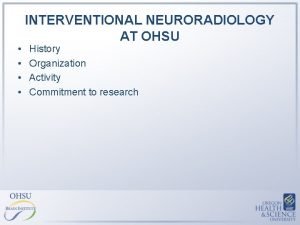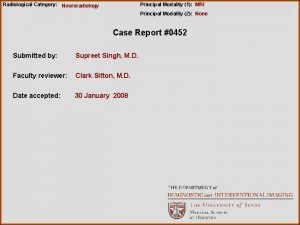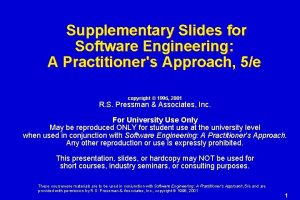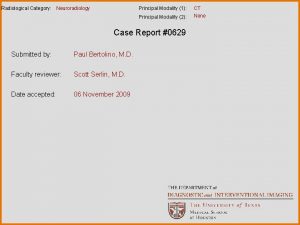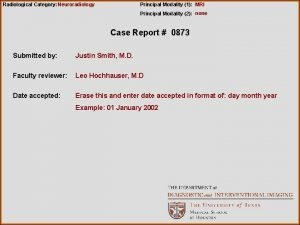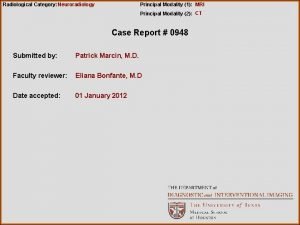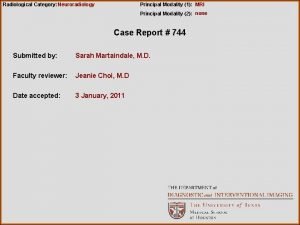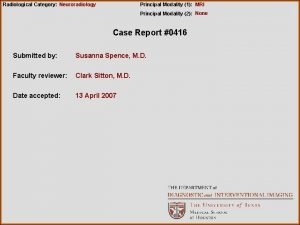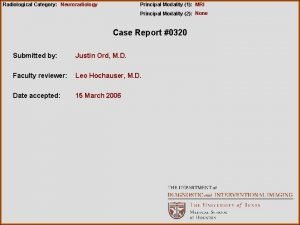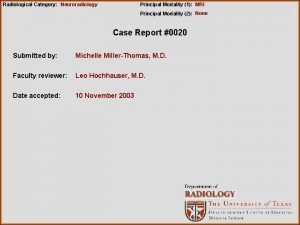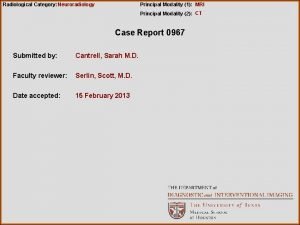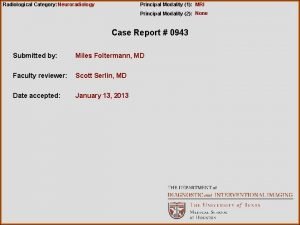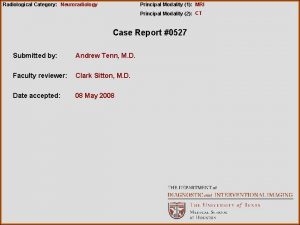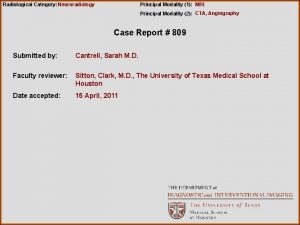Radiological Category Neuroradiology Principal Modality 1 MRI Principal














- Slides: 14

Radiological Category: Neuroradiology Principal Modality (1): MRI Principal Modality (2): Case Report # 0635 Submitted by: Ravi Bodiwala , M. D. Faculty reviewer: Clark Sitton, M. D Date accepted: 14 January, 2010

Case History 48 -year-old male who was involved in an ATV accident in 8/2009, which resulted in a dens fracture. The patient was treated non-operatively and placed in a halo for spine stabilization. The patient currently presented with a complaint of purulent drainage from his wound for approximately 3 weeks.

Radiological Presentations T 1 weighted sequence at the level of basal ganglia T 2 weighted sequence at the level of basal ganglia T 1 -post contrast sequence at the level of basal ganglia

Radiological Presentations Diffusion weighted sequence at the level of basal ganglia Apparent diffusion coefficient (ADC) images at the level of basal ganglia

Test Your Diagnosis Which one of the following is your choice for the appropriate diagnosis? After your selection, go to next page. • Glioblastoma multiforme • Intracerebral abscess with ventricular rupture • Intracerebral hematoma

Radiological Presentations T 1 weighted sequence at the level of basal ganglia T 2 weighted sequence at the level of basal ganglia T 1 -post contrast sequence at the level of basal ganglia

Radiological Presentations Diffusion weighted sequence at the level of basal ganglia Apparent diffusion coefficient (ADC) images at the level of basal ganglia

Findings and Differentials Findings: A ring-enhancing lesion is visualized in the right posterior temporal lobe, with associated diffusion restriction. There is extensive T 2 hyperintensity surrounding this ring-enhancing lesion, which represents vasogenic edema in a large portion of the right parietal and temporal lobes, as well as the basal ganglia. The medial margin of the lesion is contiguous with the occipital horn of the right lateral ventricle, which demonstrates mild ependymal enhancement. Note is also made of a fluid level within the body of the right and occipital horn of the left lateral ventricle. Laterally, the lesion extends extracranially to the scalp surface. There is 1. 2 cm midline shift to the left, which is in keeping with subfalcine herniation. Incidental note is made of bilateral symmetric osseous defects in the frontal and temporal bones, which provide an important clue about the possible etiology for this cerebral ring enhancing lesion. Differentials: • Intracerebral abscess with ventricular rupture • Glioblastoma multiforme • Intracerebral hematoma

Discussion This is a case of an intracerebral abscess that occurred due to penetrating trauma from patient’s halo device. The study was initially presented with a generic indication of “head trauma. ” However, the imaging findings provides all the clues for one to arrive at the right diagnosis. The first abnormality that one observes is a ring enhancing temporal lobe lesion. The differential for a ring enhancing cerebral lesion is extensive, but well known to residents by the mnemonic “MAGICAL DR. ” § § Metastases Asbscess § pyogenic abscess § abscesses due to atypical bacteria such as mycobacteria, nocardia, actinomyces, rhodococcus and listeria § fungal abscesses due to zygomycosis, histoplasma, coccidioides, aspergillus, and cryptococcus § Parasitic abscess due to neurocysticercosis, echinococcus and entamoeba § § § Glioma Infarct Contusion Lymphoma Demyelinating disease Resolving hematoma/radiation necrosis

Discussion The next focus of attention could be the degree of edema surrounding this ringenhancing lesion. In this case, the intense extent of edema surrounding the lesion would help one eliminate demyelinating disease and hematoma, which typically have only minimal surrounding edema. Of note, although this lesion demonstrated restricted diffusion, it did not conform to any known arterial vascular territory and therefore one could eliminate arterial infarct. There is no thrombosis of the venous sinus either, and therefore one is able to eliminate venous infarct. In the absence of clinical history, the diagnoses then left to consider are metastases, abscess and glioblastoma multiforme (GBM). The presence of diffusion restriction would strongly suggest an abscess; however, what could clinch the diagnosis would be making the observation of symmetric osseous defects within the calvarium (compatible with prior halo placement). Additionally, one would note that the ring-enhancing lesion had extracranial extension up to the scalp surface, suggesting the possibility of a penetrating halo nail that protruded through the inner calvarial table and ultimately resulted in a cerebral abscess. The abscess then ruptured into the ventricle, as indicated by fluid levels within the body of the right and occipital horn of the left lateral ventricle. The ventricular fluid also restricts diffusion due to the presence of pyogenic material.

Discussion Infectious agents most commonly gain access to the CNS by spread from a contiguous source of infection (otitis media, mastoiditis, sinusitis), or secondary to an odontogenic infection. CNS infection can also result from penetrating trauma (as in the case presented), may occur due to hematogeneous spread, or due to retrograde thrombophlebitis. MRI findings of cerebral infection vary with the time course, as listed below: • Early cerebritis stage – • Late cerebritis stage – • Ill-defined subcortical areas of T 2 /FLAIR –hyperintensity and diffusion restriction are seen. Contrast-enhanced T 1 -weighted images demonstrate poorly defined subcortical enhancing foci with mild surrounding edema. During the late cerebritis stage, a thick, irregular slightly T 1 hyperintense rim appears surrounding an area of central necrosis. The rim enhances avidly following contrast administration, and there is increased surrounding vasogenic edema when compared to the early cerebritis stage. Satellite nodules may be also be present. Early and late capsule stages – During the early and late capsule stages, a well-developed smooth walled abscess capsule is seen which enhances avidly post contrast administration. The abscess demonstrates diffusion restriction, and may have associated daughter cyst(s). If the abscess ruptures into the ventricular system, the purulent ventricular material exhibits DWI signal similar to that of the central abscess cavity.

Discussion Advanced imaging techniques such as MR spectroscopy can be used to differentiate an abscess from GBM, with an elevated choline/creatine ratio seen in GBM. Chiang et al. found that the mean apparent diffusion coefficient value at the central cavity of an abscess is significantly lower than that found in a necrotic tumor. The mean relative cerebral blood volume (r. CBV) can also be used to differentiate an abscess from a necrotic tumor, with tumors exhibiting higher r. CBV value compared to an abscess. Treatment of a cerebral abscess would be directed at the causative organism. Surgical drainage may be necessary in some cases.

Diagnosis Intracerebral abscess due to penetrating trauma from a halo

References 1. Chiang I-C, Hsieh T-J, Chiu M-L, Liu G-C, Kuo Y-T, Lin W-C. Distinction between pyogenic brain abscess and necrotic brain tumor using 3 -tesla MR spectroscopy, diffusion and perfusion imaging. British Journal of Radiology 2009; 82, 813 -20 2. Guzman R, Barth A, Lovblad K-O, El-Koussy M, Weis J, Schroth G, Seiler RW. Use of diffusion-weighted magnetic resonance imaging in differentiating purulent brain processes from cystic brain tumors. Journal of Neurosurgery. November 2002; Volume 97, Number 5 3. Grossman R, Yousem D. Neuroradiology: The Requisites, 2 nd ed. Philadelphia, PA: Mosby, 2004 4. Nadalo LA, Hunter LK. Brain Abscess. Emedicine. Nov 30, 2009. http: //emedicine. medscape. com/article/336829 -overview
 Ohsu neuroradiology
Ohsu neuroradiology E-rate category 1 vs category 2
E-rate category 1 vs category 2 Radiological dispersal device
Radiological dispersal device Tennessee division of radiological health
Tennessee division of radiological health Center for devices and radiological health
Center for devices and radiological health National radiological emergency preparedness conference
National radiological emergency preparedness conference Mri principal
Mri principal Cardinality and modality
Cardinality and modality Cardinality and modality
Cardinality and modality Entity class in software engineering
Entity class in software engineering Epistemic modality
Epistemic modality Birafs
Birafs Modality statistics
Modality statistics Stefan savi
Stefan savi Modality in software engineering
Modality in software engineering
